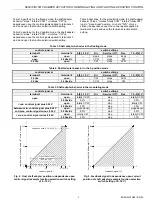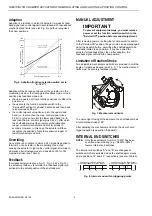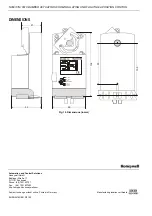
N05010/N10010 DAMPER ACTUATORS FOR MODULATING AND FLOATING/2-POSITION CONTROL
Adaption
Adaption is a function in which the actuator re-maps its feed-
back signal and control signal in accordance with repositioned
mechanical end limits (see also Fig. 6) and thus recognizes
their new positions.
fi
nal posit
io
n
of
actuat
or
(
%
of
max.)
fi
n
a
l posit
ion of
act
uat
or (de
g
rees)
0
95
0
10.0
control signal (volts)
new position of UPPER
mechanical end limit
new position of LOWER
mechanical end limit
be
for
e a
da
pt
ion
aft
er
ad
ap
tio
n
0
(before)
100
(before)
0
(after)
100
(after)
Fig. 6. Adaption (function selection switch set to
"0...10 V")
Adaption will be carried out whenever the actuator is in the
modulating mode or the floating plus feedback mode or the 2-
position plus feedback mode and
•
the user powers up (from a totally powerless condition) the
actuator; or
•
the user sets the function selection switch to the
"Service/Off" setting for at least 2 seconds and then back
to its previous setting; or
•
the control signal's value rises up into the upper dead
band (i.e. to more than the max. control signal minus
0.24 V) or drops down into the lower dead band (i.e. to
less than the min. control signal plus 0.24 V), after which
the shaft adapter must then remain at the respective
(upper or lower) mechanical end limit for at least 3
seconds. However, in this case, the actuator will then
recognize the position of only the respective (upper or
lower) mechanical end limit.
Overriding
An override is a condition in which a 24 V signal is applied to
terminal 4 of an actuator in the modulating mode, thus
causing the actuator to ignore the control signal at terminal 3,
whereupon it will instead move to a position of 50% of its
maximum stroke (see Table 3).
Feedback
If correspondingly wired (see Fig. 11, Fig. 12, and Fig. 13),
the actuator provides, via terminal 5, a feedback signal pro-
portional to the actual position of the shaft adapter.
MANUAL ADJUSTMENT
IMPORTANT
To prevent equipment damage, you must remove
power or set the function selection switch to the
"Service/Off" position before manual adjustment.
After removing power or setting the function selection switch
to the "Service/Off" position, the gear train can be disengaged
using the declutch button, permitting the shaft adapter to be
manually rotated to any position. If you have wired the
actuator for feedback signal, then, after adaption, the
feedback signal will follow the new position.
Limitation of Rotation Stroke
Two adjustable mechanical end limits are provided to limit the
angle of rotation as desired (see Fig. 7). The mechanical end
limits must be securely fastened in place.
Fig. 7. Mechanical end limits
To ensure tight closing of the dampers, the shaft adapter has
a total rotation stroke of 95°.
After adjusting the mechanical end limits, the user should
trigger adaption (see section "Adaption").
INTERNAL END SWITCHES
NOTE:
Only those actuators for which "-SW2" has been
specified when ordering (e.g.: "N05010-SW2")
feature internal end switches.
The internal end switches "A" and "B" are changeover
switches which are activated when the shaft adapter moves
past a position of 5° and 85°, respectively (see also Table 5).
-2.5°
92.5°
5°
10°
15°
0°
90°
85°
80°
75°
changeover switch A activated
when shaft adapter moves past 5°
changeover switch B activated
when shaft adapter moves past 85°
Fig. 8. Internal end switch triggering points
EN0B-0478GE51 R0105
4


























